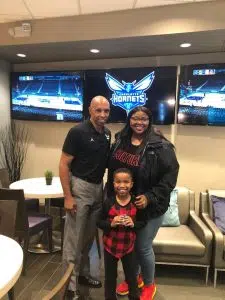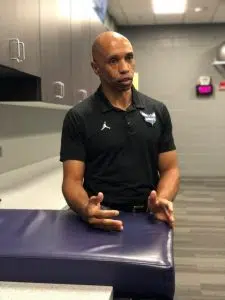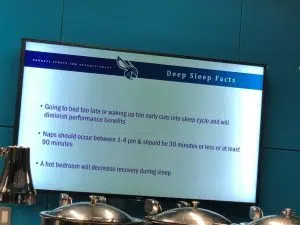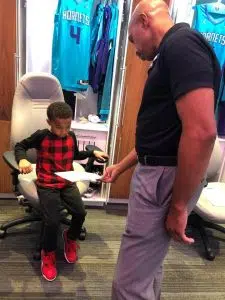Only 34% of public high schools have full-time athletic trainers (ATs). Although this statistic shows the great work of many schools to ensure that our athletic children are safe, this statistic is alarming because it also shows that we have a long way to go to ensure ALL children are safe when engaging in athletics. We, as parents, can be that vehicle of change to bring ATs to all schools! As a parent, I was completely ignorant of what athletic trainers do until I had the opportunity of a lifetime.
This post is sponsored by the National Athletic Trainers’ Association.
 On Tuesday, December 10, 2019, I had the amazing opportunity to meet the Director of Health Care and Sports Performance and Head Athletic Trainer for the Charlotte Hornets, Joe Sharpe. We were able to tour the facility and ask questions about concerns I have with letting my son, Romeo, play sports. This session was so valuable and enlightened me on all that athletic trainers do to advocate for the health of our children. All parents should want this full-time asset on their child’s team because it makes a difference when they have a true relationship with your child through practices and training and not just a game.
On Tuesday, December 10, 2019, I had the amazing opportunity to meet the Director of Health Care and Sports Performance and Head Athletic Trainer for the Charlotte Hornets, Joe Sharpe. We were able to tour the facility and ask questions about concerns I have with letting my son, Romeo, play sports. This session was so valuable and enlightened me on all that athletic trainers do to advocate for the health of our children. All parents should want this full-time asset on their child’s team because it makes a difference when they have a true relationship with your child through practices and training and not just a game.
To be that vehicle of change to ensure all children are safe when playing sports and being active, we have to educate ourselves on the benefits of athletic trainers, how schools and youth sports teams can employ athletic trainers, and most importantly, what we can do as parents.
The Benefits of Athletic Trainers
Athletic trainers, or ATs, are health care professionals specifically trained in the prevention of injury and illnesses, emergency care, examination and diagnosis of injury, therapeutic interventions and rehabilitation. Some of the injuries and illnesses that ATs are trained to treat include concussion, heat stroke, asthma attacks, spine injuries, and sudden cardiac arrest.
Athletic trainers who work full time at a school play a unique role and are able to communicate daily with players, coaches, parents and other health care providers about health concerns in youth athletes. They discuss diet and sleep patterns, as well as preventative care. The ultimate goal is for the athletic trainer to reduce the risk injury or illness, or intervene before it worsens and adversely affects the player. Many athletes who work with full-time ATs take part in regular wellness screenings to assess their mental, physical and emotional health and avoid illness and injury.
Because athletic trainers are so prevention-focused, Joe stated, “I would advocate that athletic trainers are more beneficial at the middle school level than the pro level (where every team has multiple full-time ATs) because of the ability to prevent injuries before the child is in high schools and college.” While injuries are sometimes part of any game, the ATs’ focus on prevention helps ensure that the child will have a safe and healthy journey while playing sports they are passionate about on a higher level.
 Athletic trainers are also a trusted source that has the best interest of the player. Sometimes coaches are overwhelmed with focusing on winning the game that they tend to overlook changes that a player may be experiencing mentally and physically. When these changes occur, athletic trainers have the authority to advocate for the overall health of the player not only because of their relationship with the coaches but also their robust training and education on the health of athletes.
Athletic trainers are also a trusted source that has the best interest of the player. Sometimes coaches are overwhelmed with focusing on winning the game that they tend to overlook changes that a player may be experiencing mentally and physically. When these changes occur, athletic trainers have the authority to advocate for the overall health of the player not only because of their relationship with the coaches but also their robust training and education on the health of athletes.
Prevention is a huge part of what athletic trainers do but they are also a great asset for emergency and post-injury care as well. ATs act as gatekeepers when a player is injured or ill. They know where to triage players, assess the injury or illness and provide onsite treatment or make the necessary referral for emergency or specialized care. ATs have great relationships with local physicians and can oftentimes expedite the process and reduce the headache that can come with navigating the health care system. ATs are able to call the orthopedic clinician for musculoskeletal injuries, cardiologist for heart concerns, or even a family physician, internist or pediatrician for an issue like the flu or pneumonia. Having an AT on your child’s team could be the difference between life or death in a dire situation.
What can public schools do?
Our schools need to invest in putting a full-time athletic trainer in the budget for athletics. Although this is an ask in terms of finances, there should be no cost too great when it comes to the health and safety of our children. Even if the public school is poorly financed, there are various employment options to help bring an athletic trainer on staff. Administration can get creative and partner with local universities, hospitals or clinics to brainstorm an option. When it comes to the health and safety of our children, schools can’t afford not to employ an AT. 
What can parents do?
As parents, we are that voice of change! We can advocate for our children to school leadership requesting that they consider employing full-time athletic trainers. While advocating for this change, we can also support the health and safety of our children at home. Joe Sharpe shared some amazing tips on how parents can help their child athletes at home:
- Do not allow your child to specialize in one sport year-round. Allow your child to play different sports and activities to train different muscles. Playing only one sport and working the same set of muscles will have the child more prone to injury. Read more about youth sports specialization.
- Be a support system for your child rather than a coach off the field. Your child should never be discouraged about losing a game. Teach your children to control what they can control. Always encourage your young athlete to have fun, be a good teammate, and play hard. Once the child realizes you are their advocate, they are willing to share more with you. Having this constant communication with your child will help you be the first line of defense because they will come to you when they have aches and pains. Read more about the role of parents of young athletes.
- Assist with preventive care at the home. The two biggest things we can do to ensure our children grow healthy is to provide a healthy, well-balanced diet and promote good sleep habits. As parents, we can make healthy food taste good and ensure that our children proper rest. Learn more about nutrition and sleep.
 The information presented above should not only inform you about the importance of athletic trainers but motivate you to be a vehicle or voice of change for your athletic children. As parents, we will do whatever it takes to protect our beautiful children from harm and athletic trainers will help with that mission. I encourage you all, especially the parents of athletes, to take the steps in advocating for full-time athletic trainers in your local schools to ensure ALL children are safe and healthy.
The information presented above should not only inform you about the importance of athletic trainers but motivate you to be a vehicle or voice of change for your athletic children. As parents, we will do whatever it takes to protect our beautiful children from harm and athletic trainers will help with that mission. I encourage you all, especially the parents of athletes, to take the steps in advocating for full-time athletic trainers in your local schools to ensure ALL children are safe and healthy.











